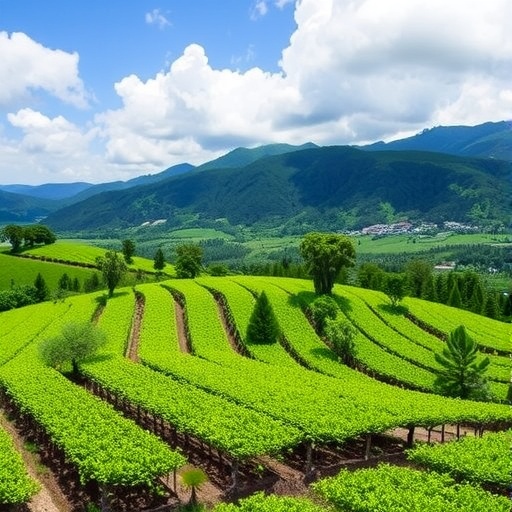The dynamic relationship between climate change, carbon markets, and agroforestry systems is gaining unprecedented attention in today’s environmental discourse. The rise of carbon markets, coupled with the multiple functions of agroforestry practices, positions this sector as a beacon of hope in combating greenhouse gas emissions. Researchers Awazi, Alemagi, and Ambebe have put forth compelling arguments regarding the need for robust global, national, and sectoral initiatives to promote carbon markets within agroforestry systems. Their 2025 study sheds light on how integrated strategies can harness the full potential of agroforestry in climate mitigation efforts.
Carbon markets are complex systems that facilitate the trading of carbon credits, which are generated through verified emissions reductions. Agroforestry, in which trees and shrubs are integrated into agricultural landscapes, provides critical ecosystem services while also sequestering carbon in both biomass and soil. This dual function not only contributes to biodiversity conservation but also enhances the resilience of agricultural systems against climate-related threats. The intricacies of these interactions form the crux of the ongoing discussions in environmental science.
The article highlights several global initiatives that support carbon markets and agroforestry systems, with a focus on programs that encourage sustainable land management. International climate agreements, such as the Paris Accord, underscore the need for policy frameworks that can effectively engage various stakeholders, including farmers, governments, and private enterprises. These agreements emphasize the importance of setting legally binding targets for emissions reduction, which can provide the necessary impetus for nations to invest in agroforestry projects.
National governments play a crucial role in shaping the regulatory landscape surrounding carbon markets. By developing policies that incentivize sustainable agricultural practices, countries can create an environment conducive to carbon trading. For instance, certain nations have implemented tax breaks or subsidies for farmers who adopt agroforestry practices, effectively rewarding them for their contributions to carbon sequestration. The authors argue that such policy initiatives are not merely beneficial—they are essential for the widespread adoption of climate-smart agriculture techniques.
Sectoral initiatives further contribute to this ecosystem by integrating various forms of expertise into lengthier supply chains. For example, initiatives that bring together agronomists, ecologists, and economists can foster a more nuanced understanding of how agroforestry practices can adapt to changing market conditions. Through collaboration and knowledge sharing, these sectoral efforts can ensure that the technical aspects of carbon markets are translated into actionable, on-the-ground practices. This multidisciplinarity is a hallmark of effective climate action that has proven fruitful in several case studies.
Moreover, the study emphasizes the need for financing mechanisms that support the establishment of carbon markets in agroforestry systems. Innovative funding models, such as payment for ecosystem services (PES), allow environmental service providers—like those who engage in agroforestry—to receive financial compensation for their carbon-sequestering efforts. These financial tools can empower rural communities to invest in sustainable practices while simultaneously benefiting from transmission of their sustainable practices to carbon credit buyers.
Exporting carbon credits to wealthier nations underpins the global carbon market, resulting in significant financial inflows into developing countries. Such transactions can help alleviate poverty and enhance local economies, while also contributing to the collaborative global effort in fighting climate change. The genesis of this exchange highlights the interconnected nature of environmental, social, and economic outcomes facilitated by agroforestry systems.
The topic of technology adoption within agroforestry systems deserves notable mention as well. The proliferation of remote sensing tools, GIS (Geographic Information Systems), and other digital innovations are transforming the ways in which farmers can monitor land-use changes and calculate carbon sequestration. These technologies enable farmland owners to substantiate their claims to carbon credits, which can then attract investment from carbon markets. The authors indicate that increasing the accessibility of sufficient technologies remains a critical factor in this endeavor.
Additionally, understanding the variances in agroecological contexts can allow for tailored carbon solutions. Different regions have unique requirements and challenges concerning their agricultural systems and environmental conditions. The diversity in agroforestry practices across various geographies underscores the necessity of localized strategies when implementing global or national initiatives. Research into indigenous practices and traditional ecological knowledge can also inform adaptive management strategies that emphasize social equity and cultural relevance.
Furthermore, the socio-political dimensions surrounding these initiatives cannot be overlooked. Historically marginalized groups, including indigenous peoples and smallholder farmers, often bear the brunt of environmental degradation while having limited access to participation in carbon markets. Empowering these communities, by ensuring their active roles in decision-making processes, is essential for promoting equitable outcomes in agroforestry systems. The study argues for policies that prioritize inclusivity and social justice as they relate to carbon market initiatives.
Lastly, the ongoing challenges posed by land degradation, deforestation, and climate variability present a rich terrain for academic inquiry. Garnering insights from these global challenges can guide the trajectory of research in agroforestry systems, creating a feedback loop through which practical solutions can emerge. Strategic investment in research and development for agroforestry systems will enhance their environmental performance and economic viability.
In conclusion, the promotion of carbon markets within agroforestry systems represents an innovative frontier in climate change mitigation. The central message delivered by Awazi, Alemagi, and Ambebe is clear: Leveraging global, national, and sectoral initiatives can catalyze the transformation needed to employ agroforestry systems effectively. As these researchers articulate, the urgency of climate action demands cooperative efforts across various spheres—economic, ecological, and social. By fostering collaboration, leveraging technological advancements, and prioritizing inclusivity, stakeholders can unlock the immense potential of agroforestry systems in the fight against climate change.
Subject of Research: The promotion of carbon markets in agroforestry systems through global, national, and sectoral initiatives.
Article Title: Promoting the carbon market in agroforestry systems: the role of global, national and sectoral initiatives.
Article References:
Awazi, N.P., Alemagi, D. & Ambebe, T.F. Promoting the carbon market in agroforestry systems: the role of global, national and sectoral initiatives.
Discov. For. 1, 9 (2025). https://doi.org/10.1007/s44415-025-00013-4
Image Credits: AI Generated
DOI: 10.1007/s44415-025-00013-4
Keywords: Carbon markets, agroforestry, climate change, sustainability, ecosystem services, policy initiatives, socio-political dimensions, technology adoption.




